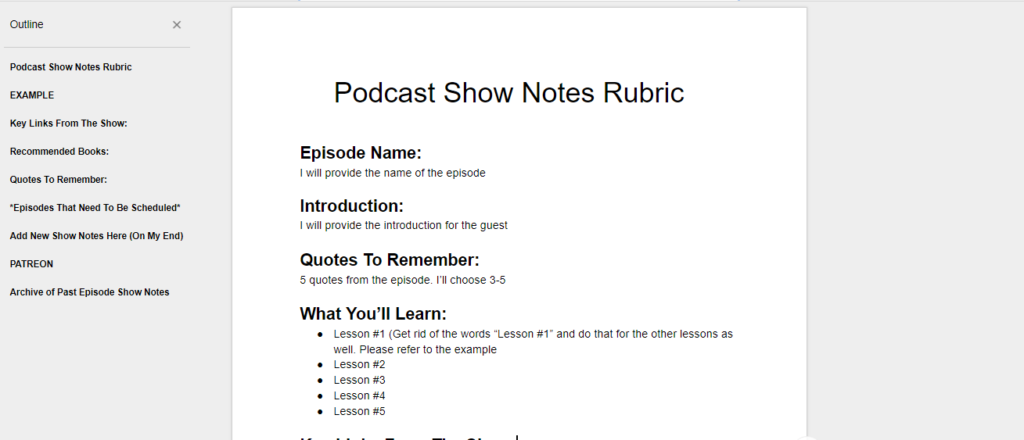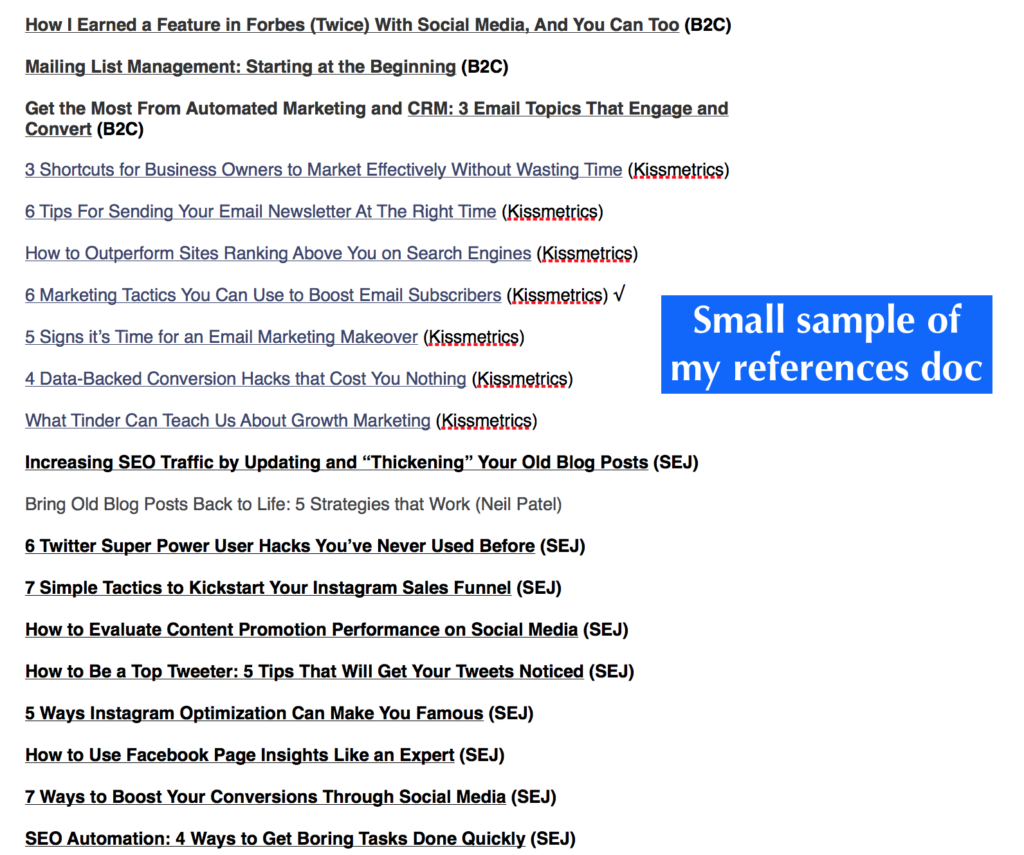When you first start creating content, it’s easy to think of epic content ideas. The world is your oyster, and anything you can think of hasn’t been covered.
As you create more content, the ideas become more limited. Over 1,500 blog posts later, I have to make sure I don’t get too repetitive. I don’t see myself writing a “5 Ways To Get More Twitter Followers” type of article for a very long time, if ever again.
It’s easy to think of epic content ideas. It’s difficult to think of new ideas that you haven’t covered and that your audience wants. I can think of a blog post listing 100 blogging tips, but I already did that.
You can take a topic you’ve discussed before and discuss it in a new piece of content. If you chooses this route, you need to do so with a different flavor than before.
Regardless of your approach, these are 10 tactics you can use to think of epic content ideas.
#1: Read Blog Post Headlines
Blog post headlines allow you to discover what a blog post will discuss before reading it. You knew what you were getting from this blog post the moment you read the headline.
For some blog posts, it’s worth reading the entire thing to grab some key points. Hopefully, this is that type of blog post for you.
However, some blog post headlines serve better as idea igniters. If you run out of ideas, you can read blog post headlines in your niche to spark your mind.
I’ll read as many headlines as I need so I can come up with an epic content idea. However, to save time from this activity in the future, I often jot down 10-15 content ideas so I don’t have to perform this same activity every day.
#2: Read Email Subject Lines
This is a similar practice as reading blog post headlines. The main difference is that you read email subject lines continuously without igniting your mind. How many of us go through our inboxes and think, “Wow, there are so many potential content ideas lurking here”?
When I’m in the inbox, I want to respond to important emails and then get out. However, the inbox magic always seems to keep us in our inboxes a little longer than we anticipated.
Instead of completely wasting this time, have a mind that is open to new content ideas. Sometimes, blog post headlines make their way into your inboxes.
I’m subscribed to Medium, and they send amazing emails based on articles I’ve read in the past. One of the articles I received in my inbox was called 16 Things Your Successful Friends Have Given Up by Tim Denning.
Not only did I read the article, but I now have a content idea for the future. I can expand on this concept and write an article like “10 Things Your Unsuccessful Friends Haven’t Given Up” or “5 Things That Hold People Back From Success.”
Similarly to a blog post headline, an email subject line can give you several content ideas if you reword the subject line.
I wrote this blog post towards the end of 2017, so I had an email in my inbox with the subject line “The number one end-of-year practice that transforms my year.” I now have a few options:
“3 End-of-Year Practices That Work At Anytime Of The Year”
“The #1 Beginning-of-Year Practice That Can Transform Your Year”
“The Only Thing You Need To Accomplish Your Resolutions”
It took me a little less than a minute to write all of those ideas. I can follow-up with them at any time I desire, and I got them from my inbox.
You might find more success in your inbox because many marketers value their email subject lines more than they value their content headlines. The email subject line, similarly to a content headline, makes the difference between massive engagement and zero engagement.
#3: Listen To Podcasts
Unashamed plug to the Breakthrough Success Podcast 🙂
All joking aside, listening to podcasts (or audiobooks, but in this case, podcasts for your breakthrough), will provide you with a fountain of content ideas.
Audio content provides you with several unique opportunities for content consumption that videos and the written word can’t safely provide:
Walking in the grocery store
Walking your dog
Running (note: I briefly tried this, but it ruined my flow so I stopped)
Driving
When you want to rest and don’t want to look at a book or a computer screen
I write notes for each episode I listen to. As I write more notes, more content ideas flow out of me.
The amount of content ideas you’ll get from each episode depends on the type of podcast you listen to. The better the podcast, the more content ideas you’ll get out of the experience.
#4: Watch Videos
This tactic has a similar vibe as listening to podcast episodes. Many see YouTube as an on-demand platform to escape the hustle and bustle of work. Others use YouTube to learn new skills and implement what they learn.
You can watch your way to more knowledge by watching the right YouTube videos. I prefer to watch videos from a training course as I’m less tempted to drift off when watching a training course. All YouTube has to do is suggest one tempting video that’s off-track, and then I can fall into the wormhole of wasted time.
I recommend enrolling into several courses on Udemy. Several of them are free and won’t distract you from learning unlike YouTube (unless you only watch educational YouTube videos without room for entertainment).
#5: Write Down Ideas
One way to think of epic content ideas is…wait for it…write down ideas.
While this may seem like one of those no-brainer and not necessary to mention type of tactics, this one is important.
Just because you think of an epic content idea doesn’t mean you’ll remember it. With tens of thousands of thoughts going through our heads each day, even the greatest of ideas can get lost in the storm.
Writing down your ideas will prevent you from forgetting them. And when you look at those ideas, two things will happen. #1 is another no-brainer but #2 is where the magic happens.
You’ll remember the idea
Your mind will start to ignite more ideas based on the idea you just remembered
All you have to do is change, remove, or add 1-2 words to a content headline to come up with an entirely new idea.
#6: Consume Your Past Content
Similarly to how looking at past ideas will ignite new ideas, consuming your past content will help you come up with new content ideas.
To finish 2017 strong, I decided to listen to every episode I published on the Breakthrough Success Podcast (a little over 60 at the time). I listened to my podcast with iTunes until my podcast made it on Spotify. Then I got hyped and listened to many of the remaining episodes on Spotify.
Among the many tidbits I got from the episodes, one was that “all successful bloggers are full-time bloggers.”
With that one quote, I can think of several ideas:
How To Become A Full-Time Blogger
How To Work Like A Full-Time Blogger
How To Become A Successful Part-Time Blogger
What You Need To Do As A Part-Time Blogger
Note that I’m using headlines that include part-time and full-time. Including two important words within various headlines will give you more options as you think of epic content ideas.
#7: Read Books
Reading books has a similar theme as some of the previously mentioned tactics. Successful content creators often use books to gather new insights and present their findings in their content.
The best way to see planned out research in action is by…reading books. When you read a book, you’ll often see the author mention another book and a valuable insight from that book. This is planned out research, and while it’s presented in other forms of content, books seem to take this amount of research to the next level.
If you prefer audiobooks, then you’ll still get a lot of value from the experience. The important thing is that you read through as many high-value, niche-related books as possible. You’ll learn a lot and come across many content ideas.
#8: Watch Training Courses
This tactic is worth saying, but I won’t go deep into it. The idea is very similar to other tactics discussed. I recommend you use Udemy and SkillShare to find free courses to get the gist. While I prefer Udemy, others prefer SkillShare.
#9: Hire A Freelancer To Gather Ideas
Here’s where things get different. Most of these tactics have focused on you consuming content and headlines to come up with the ideas.
If you find yourself pressed for time, you can hire a team of freelancers to gather ideas for you. They can even do the outlines so you know where to take the content next. That way, you can spend less time thinking about epic content ideas and more time writing epic content.
Better yet, you can spend more time marketing your brand. Many people are great at creating content, but few of these same people are great marketers. Marketing your content allows your brand to get found and aids you on the way to becoming a full-time content creator.
You can hire freelancers to conduct a variety of tasks beyond idea generation. Just because something’s hard or time consuming doesn’t always mean you specifically have to do it.
#10: Create A Survey
Hiring a freelancer to gather ideas is one way to remove this task from your workload. While hiring a freelancer for this task serves its benefits, you can also ask your audience for ideas.
The best way to ask your audience for ideas is through a survey. If enough people in your audience take the survey, you can then make conclusions about what type of content they want more of.
While you’ll get some ideas right out of the gate, this feedback will let you know where to direct your idea igniting mind. If your audience wants Facebook advice, you know that you need to focus on thinking of Facebook ideas instead of thinking of Pinterest ideas.
You can create a survey through Survey Monkey or Google Forms.
In Conclusion
Thinking of epic content ideas is no small feat. The extra time you take to think of an incredible content idea will result in better content. That better content will attract more people to your brand and ensure your existing audience wants more of your content.
What were your thoughts on these tactics for generating more content ideas? Do you have any tactics for us? Do you have a question for me? Sound off in the comments section below.


















